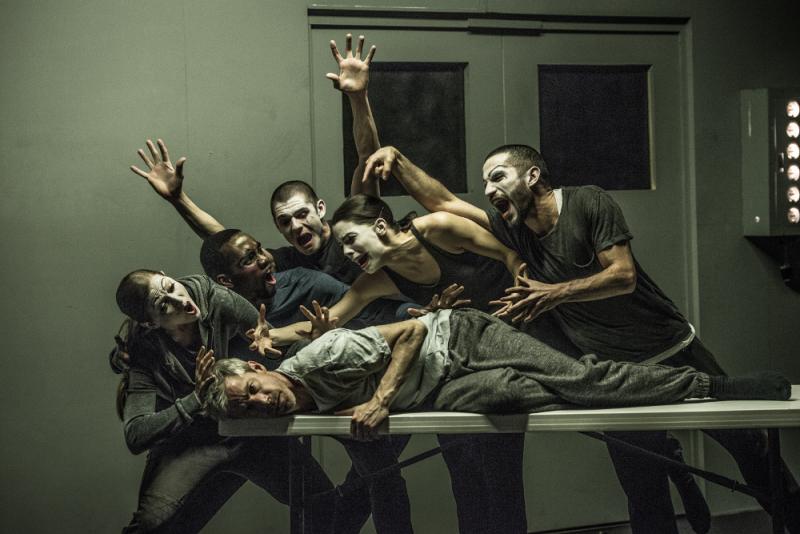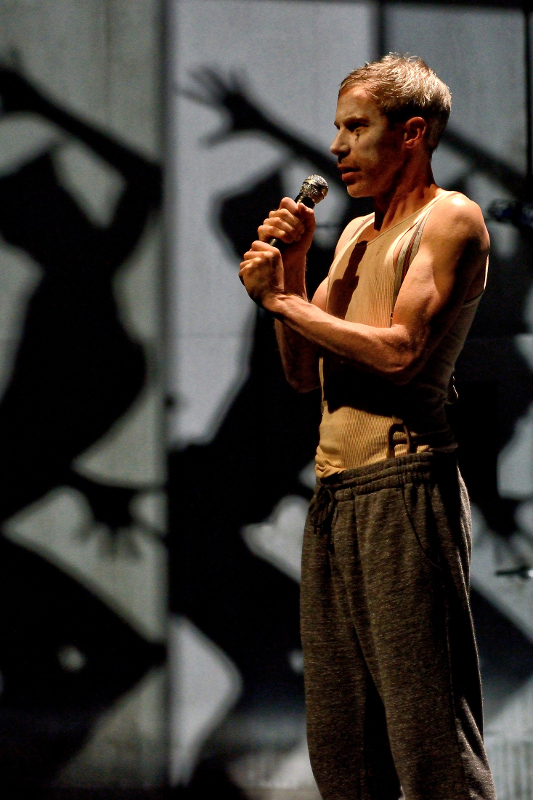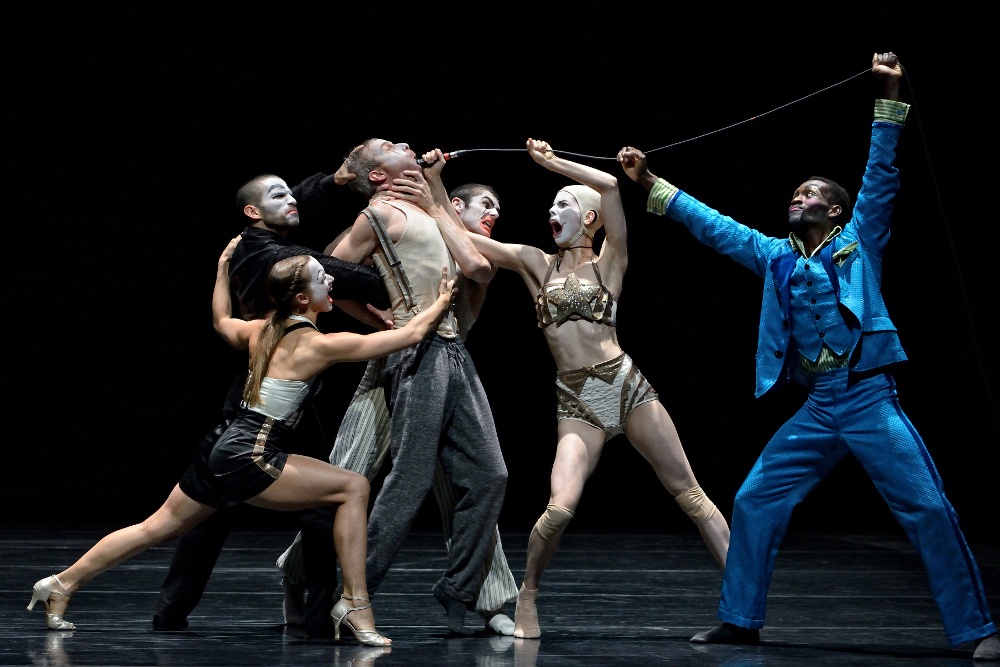Betroffenheit, Crystal Pite & Jonathon Young, Sadler's Wells | reviews, news & interviews
Betroffenheit, Crystal Pite & Jonathon Young, Sadler's Wells
Betroffenheit, Crystal Pite & Jonathon Young, Sadler's Wells
Astonishing, unclassifiable work of dance theatre about an unrepresentable subject

Where does my voice come from? Whose is my body? It’s apt that these questions run deep through a work that was created jointly by an actor, Jonathon Young, and a choreographer, Crystal Pite.
The opening scene already disorients and unsettles. In a darkened warehouse room, an electric cable snakes across the floor; another rises like a cobra up the wall, in search of its socket. Powered up, the room itself seems to speak to Young, who hunches in a corner as the lights flash in sync with a voiceover of repeated, fragmented phrases: "Oh my God", "There’s no information", "The system is failing".
 Young switches on a black-box speaker, and it speaks back in his voice. Dancer Jermaine Spivey sidles in like a shadow against the wall, his limbs twitching in sync with the speaker’s voice. When he turns to face Young, we see that he is lipsyncing too. They synchronise their stances. From here on through to the end, Young and Spivey now seem to be the same person, one whose voice appears in various guises too: live, recorded, lipsynched, located, disembodied. No wonder Young (pictured right) is having trouble holding himself together: he is all over the place.
Young switches on a black-box speaker, and it speaks back in his voice. Dancer Jermaine Spivey sidles in like a shadow against the wall, his limbs twitching in sync with the speaker’s voice. When he turns to face Young, we see that he is lipsyncing too. They synchronise their stances. From here on through to the end, Young and Spivey now seem to be the same person, one whose voice appears in various guises too: live, recorded, lipsynched, located, disembodied. No wonder Young (pictured right) is having trouble holding himself together: he is all over the place.
But he can’t escape: the room is not only where he is, it’s who he is. Instead, he escapes into a drugged, hallucinatory fantasy; he “gets out of it”. The room is invaded by nightmarish cabaret entertainers with painted faces (pictured below) – a grinning, hunched tap dancer, pink plumed showgirls, a glitzy salsa couple – and he and his other self Spivey take the stage as a bantering double-act, an imaginary audience guffawing at their every quip. Until the inevitable come-down – Young appears as a puppet version of himself, a diminished man – and then the inevitable crash, as he returns to the bare room, his sparkling fantasy figures slumped stoned around him.
Considering he had no dance training before creating this piece, Young is an astonishingly accomplished mover, holding his own in the skilfully choreographed sections with Pite’s dancers. His performance as an actor, neither sentimental nor manipulative, is wrenchingly moving, almost unbearably painful – and still, his character has more to suffer. His “system” fails: the walls of the room move away, the stage is swept by a billowing sheet of darkness, and Young collapses, the dancers clustering around his body and gesticulating to panicked voice-overs like characters in an ER drama, desperately trying to revive a critical casualty (main image).
Pite’s direction throughout this first act has been commandingly cinematic: dense with incident but with fluent scene cuts, tightly synchronised soundtrack, tracked focus, swift pacing and high tension. For the shorter second act, she shifts to a less dramatic, more dance-based mode that nonetheless – like a series of softer aftershocks – often echoes images from Act One. On a clear stage now, the dancers run ragged like the fugitive figures that we’d glimpsed before in flashes of torchlight. They replay the whole ER section as choreography, only with no voiceover and no supine patient to attend, just the motion of their own bodies. The underlying patterns of Act One are still here – in a duet of constantly collapsing support, in solos which trip up their own performers – but they feel less locked down, less tethered by trauma’s obsessive retelling of its own story.
Does this allow Young to resolve his crisis? That would be a facile, Hollywood ending. Instead Betroffenheit offers a more ambiguous loosening of ties, an opening of space – not a resolution as such, but a change of sorts. The room is still inside him, but Young is no longer inside the room.
Betroffenheit is an astonishing accomplishment. It is intense, raw and often itself traumatic; yet even as we feel its force, we notice how very finely crafted, paced and performed it is. Young’s harrowed soul is of course central to its achievement, but this is fundamentally an ensemble piece. Pite’s five dancers are marvellously versatile, whether moving to the rhythms of sputtered speech, shuddering as if in stop-motion film, or dancing full-out through dense sequences of reckless skids, skewed turns and limb-wrangling tumbles. Full credit, too, to the design team, for their inventive and effective use of light, costume, sound and set. But it’s the piece itself that grips, its imaginative treatment of a subject as intractable, as unrepresentable as trauma itself. Instead of telling the story of a trauma, it stages its patterns, follows its arcs. When you leave the theatre, its aftershocks stay with you.
- Betroffenheit is on at Sadler's Wells until 12 April. It will be screened on BBC Four, date as yet unconfirmed
- Read more dance reviews on theartsdesk
rating
Share this article
The future of Arts Journalism
You can stop theartsdesk.com closing!
We urgently need financing to survive. Our fundraising drive has thus far raised £49,000 but we need to reach £100,000 or we will be forced to close. Please contribute here: https://gofund.me/c3f6033d
And if you can forward this information to anyone who might assist, we’d be grateful.

Subscribe to theartsdesk.com
Thank you for continuing to read our work on theartsdesk.com. For unlimited access to every article in its entirety, including our archive of more than 15,000 pieces, we're asking for £5 per month or £40 per year. We feel it's a very good deal, and hope you do too.
To take a subscription now simply click here.
And if you're looking for that extra gift for a friend or family member, why not treat them to a theartsdesk.com gift subscription?
more Dance
 'We are bowled over!' Thank you for your messages of love and support
Much-appreciated words of commendation from readers and the cultural community
'We are bowled over!' Thank you for your messages of love and support
Much-appreciated words of commendation from readers and the cultural community
 How to be a Dancer in 72,000 Easy Lessons, Teaċ Daṁsa review - a riveting account of a life in dance
Michael Keegan-Dolan's unique hybrid of physical theatre and comic monologue
How to be a Dancer in 72,000 Easy Lessons, Teaċ Daṁsa review - a riveting account of a life in dance
Michael Keegan-Dolan's unique hybrid of physical theatre and comic monologue
 A Single Man, Linbury Theatre review - an anatomy of melancholy, with breaks in the clouds
Ed Watson and Jonathan Goddard are extraordinary in Jonathan Watkins' dance theatre adaptation of Isherwood's novel
A Single Man, Linbury Theatre review - an anatomy of melancholy, with breaks in the clouds
Ed Watson and Jonathan Goddard are extraordinary in Jonathan Watkins' dance theatre adaptation of Isherwood's novel
 Peaky Blinders: The Redemption of Thomas Shelby, Rambert, Sadler's Wells review - exciting dancing, if you can see it
Six TV series reduced to 100 minutes' dance time doesn't quite compute
Peaky Blinders: The Redemption of Thomas Shelby, Rambert, Sadler's Wells review - exciting dancing, if you can see it
Six TV series reduced to 100 minutes' dance time doesn't quite compute
 Giselle, National Ballet of Japan review - return of a classic, refreshed and impeccably danced
First visit by Miyako Yoshida's company leaves you wanting more
Giselle, National Ballet of Japan review - return of a classic, refreshed and impeccably danced
First visit by Miyako Yoshida's company leaves you wanting more
 Quadrophenia, Sadler's Wells review - missed opportunity to give new stage life to a Who classic
The brilliant cast need a tighter score and a stronger narrative
Quadrophenia, Sadler's Wells review - missed opportunity to give new stage life to a Who classic
The brilliant cast need a tighter score and a stronger narrative
 The Midnight Bell, Sadler's Wells review - a first reprise for one of Matthew Bourne's most compelling shows to date
The after-hours lives of the sad and lonely are drawn with compassion, originality and skill
The Midnight Bell, Sadler's Wells review - a first reprise for one of Matthew Bourne's most compelling shows to date
The after-hours lives of the sad and lonely are drawn with compassion, originality and skill
 Ballet to Broadway: Wheeldon Works, Royal Ballet review - the impressive range and reach of Christopher Wheeldon's craft
The title says it: as dancemaker, as creative magnet, the man clearly works his socks off
Ballet to Broadway: Wheeldon Works, Royal Ballet review - the impressive range and reach of Christopher Wheeldon's craft
The title says it: as dancemaker, as creative magnet, the man clearly works his socks off
 The Forsythe Programme, English National Ballet review - brains, beauty and bravura
Once again the veteran choreographer and maverick William Forsythe raises ENB's game
The Forsythe Programme, English National Ballet review - brains, beauty and bravura
Once again the veteran choreographer and maverick William Forsythe raises ENB's game
 Sad Book, Hackney Empire review - What we feel, what we show, and the many ways we deal with sadness
A book about navigating grief feeds into unusual and compelling dance theatre
Sad Book, Hackney Empire review - What we feel, what we show, and the many ways we deal with sadness
A book about navigating grief feeds into unusual and compelling dance theatre
 Balanchine: Three Signature Works, Royal Ballet review - exuberant, joyful, exhilarating
A triumphant triple bill
Balanchine: Three Signature Works, Royal Ballet review - exuberant, joyful, exhilarating
A triumphant triple bill
 Romeo and Juliet, Royal Ballet review - Shakespeare without the words, with music to die for
Kenneth MacMillan's first and best-loved masterpiece turns 60
Romeo and Juliet, Royal Ballet review - Shakespeare without the words, with music to die for
Kenneth MacMillan's first and best-loved masterpiece turns 60

Add comment